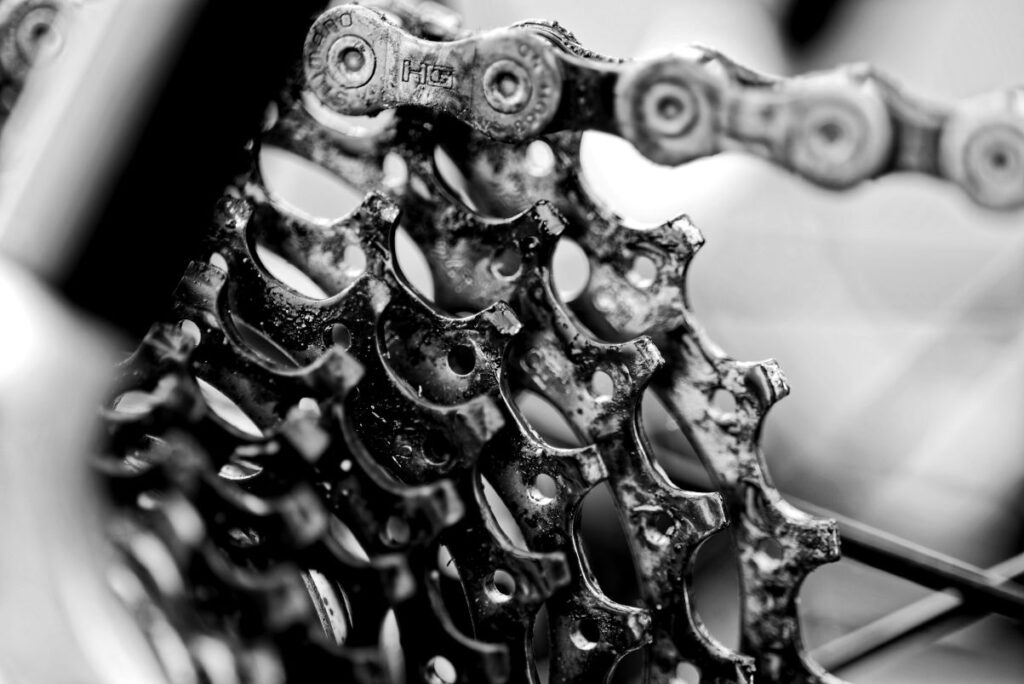Gear wear happens on all bicycles eventually. As most enthusiasts know, bikes are intricate machines that rely on components working in harmony to deliver an efficient ride. Among these components, the gears are crucial for adjusting speed and effort. Like any mechanical part however, gears are susceptible to wear and tear. Today we explore how gear wear happens, how to avoid it, the longevity of gears, how to determine gear wear levels, and tips for self-maintenance and repair.
How Gear Wear Happens
Gear wear occurs due to friction and stress. As you pedal, the chain interacts with the teeth of the gears, causing gradual erosion. This is something any mechanical device faces when there is metal on metal contact. Several factors accelerate this wear:
Friction: Constant contact between the chain and gears leads to metal-on-metal friction.
Dirt and Debris – Particles of dirt and grime can act as abrasives, accelerating the wear process.
Poor Lubrication – Lack of proper lubrication increases friction and wear. Imagine if you never changed or replaced the oil in your car for example. Not good..
Shifting Under Load: Shifting gears while applying heavy pressure can cause increased stress on the gear teeth (usually you can feel this too)
Gear wear is inevitable due to the mechanical nature of bike components. The rate at which gears wear out can be influenced by maintenance habits, riding conditions, and the quality of your components.
How to Avoid Excessive Gear Wear
While wear is unavoidable, there are several strategies to minimize it:
Regular Cleaning – Keep your chain and gears clean. Regularly remove dirt and debris to reduce friction.
Proper Lubrication – Lubricate the chain and gears regularly to ensure smooth operation and reduce wear.
Smooth Shifting – Avoid shifting gears under heavy load (try and shift before major inclines) to prevent undue stress on the gears.
Quality Components – Invest in high-quality gears and chains that are designed to withstand wear better than cheaper alternatives. Buy from reputable sellers.
Regular Maintenance – Perform routine checks and maintenance to catch wear early and make necessary adjustments or replacements.
Timing Intervals for Gear Longevity
The lifespan of bike gears varies widely, but generally we can estimate them as follows:
Casual Riders – Gears can last between 2,000 to 3,000 miles.
Regular Commuters – Expect gears to last about 1,500 to 2,500 miles.
Competitive Cyclists – Due to higher usage and stress, gears may need replacement every 1,000 to 2,000 miles.
These intervals are approximate and can be extended with proper care. Also bear in mind that unlike other components, there likely won’t be a “sudden failure” mode for gears unless pushed WAY beyond the point of discomfort.
Determining Gear Wear Levels
To determine the level of gear wear, observe these signs:
Visual Inspection – Look for shark fin-like shapes or hooked teeth, which indicate wear. You want them to look sharp and straight.
Chain Slip- A slipping chain, especially under load, often indicates worn gears.
Measurement – Use a wear indicator tool to measure the chain’s elongation, which can affect gear performance.
Noise – Unusual noises during shifting can be a sign of worn gears among other things.
Tips for Self-Maintenance and Repair
Highly recommend viewing our articles on mechanical checks before riding and basic bike component overview to prime you for gear wear repair.
Cleaning – Use a degreaser to clean the chain and gears. Rinse with water and dry thoroughly before lubrication.
Lubrication – Apply a suitable bicycle chain lubricant to the chain and gears. Wipe off excess to prevent attracting dirt.
Chain Replacement – Regularly check and replace the chain when it shows signs of wear to prevent damage to the gears. Try your best to use an ideal amount of oil.
Gear Adjustment – Ensure that the derailleurs are properly adjusted for smooth shifting. This can be done using the barrel adjuster on the shifter.
Tool Kit – Invest in a basic bike tool kit, including a chain breaker, a set of Allen wrenches, a screwdriver, and a chain wear indicator.
Learning Resources – Utilize online tutorials and guides for detailed instructions on specific repairs and maintenance tasks.
Conclusion
Maintaining and repairing your bike gears not only extends their lifespan but also ensures a safer and more enjoyable riding experience. By understanding the causes of gear wear and adopting proactive maintenance habits, you can significantly delay the inevitable wear and keep your bicycle in top condition for many miles to come.


